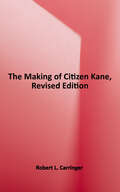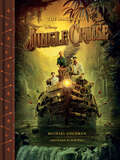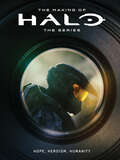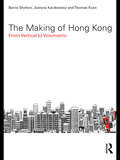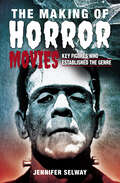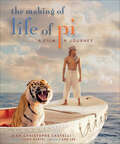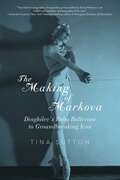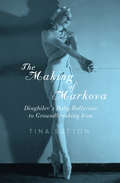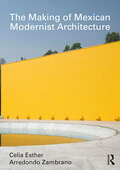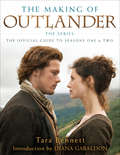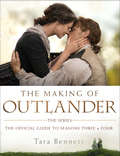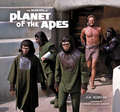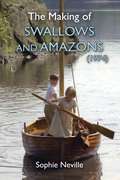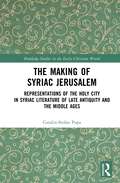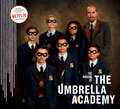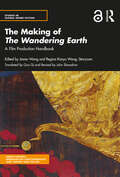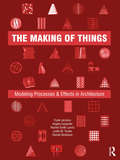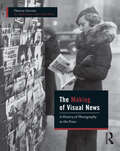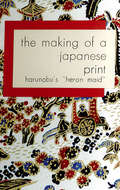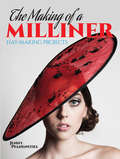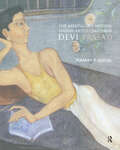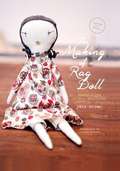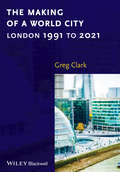- Table View
- List View
The Making of Citizen Kane, Revised edition
by Robert L. CarringerCitizen Kane, widely considered the greatest film ever made, continues to fascinate critics and historians as well as filmgoers. While credit for its genius has traditionally been attributed solely to its director, Orson Welles, Carringer's pioneering study documents the shared creative achievements of Welles and his principal collaborators. The Making of Citizen Kane, copiously illustrated with rare photographs and production documents, also provides an in-depth view of the operations of the Hollywood studio system. This new edition includes a revised preface and overview of criticism, an updated chronology of the film's reception history, a reconsideration of the locus of responsibility of Welles's ill-fated The Magnificent Ambersons, and new photographs.
The Making of Disney's Jungle Cruise (Disney Editions Deluxe)
by Michael GoldmanLike the famed theme park attraction and brand-new feature film that this volume examines, The Making of Disney’s Jungle Cruise takes readers on a unique and fascinating journey. It’s an odyssey through the history and legacy of one of the most original ideas ever to come out of Walt Disney’s fertile mind, first planned for the opening of his revolutionary new theme park in 1955. This book travels from the debut of what was called the Jungle River Cruise on Disneyland’s opening day, through the arrival at long last of the thrilling feature film starring Dwayne Johnson and Emily Blunt and directed by Jaume Collet-Serra.On Disneyland’s opening day of July 17, 1955, the park’s first guests boarded authentically styled riverboats to take the first Jungle Cruises. This unique riverboat-themed attraction in Adventureland takes visitors on a short journey down expertly simulated versions of the most prominent tropical rivers of the world, including the Amazon and the Nile, to witness wild animals, exotic sights, and thrills only a handful of intrepid real-world explorers had experienced in the past. A hilarious (and “punny”) Jungle Cruise skipper narrates all the sights and action from beginning to end. This Jungle Cruise experience would ultimately be woven into three other Disney parks, where the ride was likewise an opening-day attraction—simulating comedic high-adventure cruises through rivers in the continents of South America, Africa, and Asia. Fast-forward decades and, at long last, production on the movie commenced. The project was influenced by director Jaume Collet-Serra’s love of The African Queen, Indiana Jones films, and Romancing the Stone, among others, and built on the foundation of key elements of the theme park attraction. From the re-creation of the Amazon River to the film’s hilarious take on famous skipper puns and the reams of Easter eggs for longtime fans, the Jungle Cruise movie captures the same excitement and joy as the theme park attraction, and
The Making of Halo The Series: Hope, Heroism, Humanity
by Microsoft 343 IndustriesOur deadliest weapon is our greatest hope.Get an exclusive, behind-the-scenes look at Paramount+&’s adaptation of the wildly popular Halo series. See what went into bringing the Master Chief and his team of Spartan supersoldiers to life in their war against the alien threat known as the Covenant.This book contains never-before-seen photographs from the sets, production artwork, shots of the props and armor, as well as commentary from the team that created the show!
The Making of Hong Kong: From Vertical to Volumetric (Planning, History and Environment Series)
by Thomas Kvan Justyna Karakiewicz Barrie SheltonThis book investigates what the history of Hong Kong’s urban development has to teach other cities as they face environmental challenges, social and demographic change and the need for new models of dense urbanism. The authors describe how the high-rise intensity of Hong Kong came about; how the forest of towers are in fact vertical culs de sac; and how the city might become truly ‘volumetric’ with mixed activities through multiple levels and 3D movement networks incorporating ‘town cubes’ rather than town squares. For more information, visit the authors' website: http://www.makingofhk.com/makingofhk.swf
The Making of Horror Movies: Key Figures who Established the Genre
by Jennifer SelwayTraces society’s changing preoccupations as reflected in horror films, including biographies of all your favorite, classic horror stars.Horror films divide opinion. It wasn’t until 1973 that a horror film (The Exorcist) was nominated for an Oscar for Best Picture and many respected critics still regard them with amused condescension. The public’s view is also sharply divided. Some cinema goers revel in the thought of being made very, very afraid, while some just don’t like horror films because they don’t want to be frightened. This guide, which is for both the fan and the more faint-hearted, steers an illuminating path through a genre that has, since the early days of cinema, split off into many sub-divisions - folk horror, slasher movies, Hammer, sci-fi horror, psychological thrillers, zombie movies, among others. Times change but movie-makers can always find a way to tap into what we fear and dread, whether it’s blood-sucking vampires or radioactive mutations, evil children or the living dead. This book also gives concise biographies of the many actors and directors who saw their careers – for better or worse – defined by their association with horror movies, and who created a genre that is instantly recognisable in all its forms and continues to find new and ingenious ways of scaring us in the dark.
The Making of Juana of Austria: Gender, Art, and Patronage in Early Modern Iberia (New Hispanisms: Cultural and Literary Studies)
by Anne J. Cruz Annemarie Jordan Maria Angeles Toajas Vanessa De Cruz Medina Kelley Helmstutler Di Dio Sheila Ffolliott Ana García Sanz José Luis Gonzalo Sánchez-Molero Palma Martinez Burgos M. J. Rodriguez-SalgadoEdited by art historian Noelia García Pérez, this first-ever collection of essays on Juana of Austria, the younger daughter of Holy Roman Emperor Charles V and sister to Philip II of Spain, offers an interdisciplinary study of the Habsburg princess that addresses her political, religious, and artistic dimensions. The volume’s contextual framework shows her sharing agency with other women of her dynastic family who governed in the sixteenth century and developed an outstanding reputation for promoting artists and works of art. The Making of Juana of Austria demonstrates how Juana’s role as a leading patron of the arts offered her a means of creating her own image, which she then promulgated through the objects she collected and her crowning architectural endeavor, the Monastery-Palace of the Descalzas Reales. Drawing on early modern literature, archival documents, and artworks, the essays in this volume delineate a new portrait of Juana of Austria. Contributors not only highlight her multiple facets—princess of Portugal, regent of Castile, and the only female Jesuit in history—but also show her as a discerning art patron and collector who pursued an active role of patronage, through which she constructed her own art collection and used it to articulate a visual statement of her lineage, power, and religious convictions. Her role as an art promoter culminated with the foundation of the Descalzas Reales and the works of art she collected and displayed within its walls. The Making of Juana of Austria offers a new perspective on female rule and patronage, exploring the achievements of a crucial figure in the history of art, court, and gender in early modern Europe.
The Making of Life of Pi: A Film, a Journey
by Jean-Christophe CastelliDiversely illustrated with 275 photographs and illustrations, The Making of Life of Pi tells the inside story of how renowned Academy Award-winning director Ang Lee brought Yann Martel's international bestseller to life as a 3-D film.With a rich, entertaining text and a wide variety of facts, anecdotes, visual portfolios, and sidebars sure to delight readers of all ages, The Making of Life of Pi follows the making of the film from pre-production through final cut. Of course, you'll meet Suraj Sharma, the sixteen-year-old unknown Indian high-school student who won the part of Pi although he had no acting experience and didn't even know how to swim—yet in the end performed all of his own stunts. You'll learn about the massive wave tank, custom-built for the film that replicated a vast, stormy ocean in all its moods, thanks to a complex and specially devised menu of wave and wind combinations, some really powerful machinery, and tons of water. You'll get to look inside the fifty-page fully illustrated "survival guide" that shipwreck survivor Steven Callahan created for Pi to consult on his raft. And you'll read about King, Themis, Minh, and Jonas, the four Bengal tigers used in the film—and discover how visual effects were able to create a seamless 3-D image of the tiger Richard Parker.A foreword by Yann Martel, an introduction by Ang Lee, and an incredible range of visual materials—fine art, vintage archival imagery, and commissioned portfolios by photographer Mary Ellen Mark and artist Alexis Rockman—supplement the film's storyboards, sketches, and stills, rounding out this highly experiential book for lovers of the novel and film viewers alike.
The Making of Markova: Diaghilev's Baby Ballerina To Groundbreaking Icon
by Tina SuttonIn pre-World War I England, a frail Jewish girl is diagnosed with flat feet, knock knees, and weak legs. In short order, Lilian Alicia Marks would become a dance prodigy, the cherished baby ballerina of Sergei Diaghilev, and the youngest ever soloist at his famed Ballets Russes. It was there that George Balanchine choreographed his first ballet for her, Henri Matisse designed her costumes, and Igor Stravinsky taught her music—all when the re-christened Alicia Markova was just 14. Given unprecedented access to Dame Markova&’s intimate journals and correspondence, Tina Sutton paints a full picture of the dancer&’s astonishing life and times in 1920s Paris and Monte Carlo, 1930s London, and wartime in New York and Hollywood. Ballet lovers and readers everywhere will be fascinated by the story of one of the twentieth century&’s great artists.
The Making of Markova: Diaghilev's Baby Ballerina to Groundbreaking Icon
by Tina SuttonAs improbable as it is inspiring, the story of one of the greatest ballerinas of the twentieth century; her fortitude and reinvention; and her journey from the Ballets Russes, Balanchine, and Matisse to international stardom In pre-World War I England, a frail Jewish girl--so shy she barely spoke a word until age six and so sickly she needed to be homeschooled--is diagnosed with flat feet, knock knees, and weak legs. In short order, Lilian Alicia Marks would become a dance prodigy, the cherished baby ballerina of Sergei Diaghilev, and the youngest ever soloist at his famed Ballets Russes. It was there that George Balanchine choreographed his first ballet for her, Henri Matisse designed her costumes, and Igor Stravinsky taught her music--all when the re-christened Alicia Markova was just fourteen. But the timid British dancer would be forced to overcome poverty, jealousy, anti-Semitism, and prejudices against her unconventional looks to become the greatest classical ballerina of her generation--and one of the most celebrated, self reliant, and adventurous. A true ambassador of ballet, Markova co-founded touring companies, traveled to the far corners of the world, and was the first ballerina to appear on television. Given unprecedented access to Dame Markova's intimate journals and correspondence, Tina Sutton paints a full picture of the dancer's astonishing life and times in 1920s Paris and Monte Carlo; 1930s London; and wartime in New York and Hollywood. Ballet lovers and readers everywhere will be fascinated by the story of one of the twentieth century's great artists.
The Making of Medieval Rome: A New Profile of the City, 400 – 1420
by Hendrik DeyIntegrating the written sources with Rome's surviving remains and, most importantly, with the results of the past half-century's worth of medieval archaeology in the city, The Making of Medieval Rome is the first in-depth profile of Rome's transformation over a millennium to appear in any language in over forty years. Though the main focus rests on Rome's urban trajectory in topographical, architectural, and archaeological terms, Hendrik folds aspects of ecclesiastical, political, social, military, economic, and intellectual history into the narrative in order to illustrate how and why the cityscape evolved as it did during the thousand years between the end of the Roman Empire and the start of the Renaissance. A wide-ranging synthesis of decades' worth of specialized research and remarkable archaeological discoveries, this book is essential reading for anyone interested in how and why the ancient imperial capital transformed into the spiritual heart of Western Christendom.
The Making of Mexican Modernist Architecture
by Celia Esther Arredondo ZambranoThis book presents the making of Mexican Modernist architecture through five power structures – academic, social status, economic/political, gender, and postcolonial – and by interviews and analysis of 13 key Mexican architects. These include Luis Barragán, José Villagrán García, Juan O’Gorman, Pedro Ramírez Vázquez, Agustín Hernández, Abraham Zabludovsky, Carlos Mijares, Ricardo Legorreta, Juan José Díaz Infante, Enrique Norten, Alberto Kalach, Javier Sordo Madaleno and Clara de Buen. Although the five power structures framed what was built, the testimony of these Mexican architects helps us to recognize and discover subtleties and nuances. Their views thereby shed light on what contributed to making Mexican Modernist architecture so distinctive globally. Even if these architects were not always aware of the power structures, their projects nonetheless supported discrimination, marginalization and subjugation. In that sense the book also reveals the extent to which these power structures are still present today. The Making of Mexican Modernist Architecture’s uniqueness lies in uncovering the remarkable buildings that arose amid the five power structures while at the same time questioning their validity. It also voices the urgent need today for a new kind of architecture outside these boundaries. The book is essential reading for anyone studying Mexican and Latin American architecture.
The Making of Outlander: The Official Guide to Seasons One & Two
by Diana Gabaldon Tara BennettGet an exclusive look behind the scenes of the first two seasons of Outlander with this official, fully illustrated companion to the hit Starz television series based on the bestselling novels. It was only a matter of time before Diana Gabaldon's bestselling Outlander saga made the leap from book to hit TV series, and the millions of readers captivated by the epic romance of Claire Beauchamp Randall and Jamie Fraser have eagerly followed. Now the must-watch drama has inspired this must-have guide, which reveals that it takes a village (or perhaps a Scottish isle) to bring the breathtaking world of Outlander to life in front of our eyes. Spanning the first two seasons of the Starz network sensation, The Making of Outlander leads readers behind the scenes and straight into the action as cast members, writers, producers, musicians, costume designers, set decorators, technicians, and more share the many adventures and challenges they face to make this sweeping saga come alive on the screen. In exclusive interviews, the show's stars, including Caitriona Balfe (Claire), Sam Heughan (Jamie), and Tobias Menzies (Frank Randall/Black Jack Randall), discuss the daunting task of embodying some of fiction's most beloved characters--and satisfying the high expectations of devoted Outlander readers. Executive producer and showrunner Ronald D. Moore looks at the inner workings of the writers' room, shares his crew's travels to the authentic overseas locations, and chronicles the brainstorming, building, breakneck pacing, and boundless energy that make everything from the show's architecture to its outfits period-perfect. In addition, the book examines all the Outlander episodes through exclusive interviews with their writers and directors, providing fascinating facts into the making of each hour. Best of all, The Making of Outlander offers a veritable feast of lavish photographs--including an array of images spotlighting the stars in all their characters' grandeur and up-close personal portraits. Featuring an introduction by Diana Gabaldon herself, this magnificent insider's look at the world of the Outlander TV series is the companion all fans will want by their side.From the Hardcover edition.
The Making of Outlander: The Official Guide to Seasons Three & Four (Outlander)
by Tara BennettSee how the story of Jamie Frasier and Claire Beauchamp Randall comes to life on the screen with this official, photo-filled companion to the third and fourth seasons of the hit Starz television series based on Diana Gabaldon’s bestselling Outlander novels. From its very first episode, the Outlander TV series transported its viewers back in time, taking us inside the world of Diana Gabaldon’s beloved series. From the Scottish Highlands, to the courts of Versailles, to the shores of America, Jamie and Claire’s epic adventure is captured in gorgeous detail. Now, travel even deeper into the world of Outlander with this must-have insider guide from New York Times bestselling author and television critic Tara Bennett. Picking up where The Making of Outlander: Seasons One & Two left off, this lavishly illustrated collectors’ item covers seasons three and four, bringing readers behind the scenes and straight onto the set of the show. You’ll find exclusive interviews with cast members, including detailed conversations with Caitriona Balfe and Sam Heughan (on-screen couple and real-life friends), as well as the writers, producers, musicians, costume designers, set decorators, technicians, and more whose hard work and cinematic magic brings the world of Outlander to life on the screen. Every page features gorgeous photographs of the cast, costumes, and set design, including both official cast photography and never-before-seen candids from on set. The Making of Outlander: Seasons Three & Four is the perfect gift for the Sassenach in your life—and the only way to survive a Droughtlander!
The Making of Planet of the Apes
by Jonathan RinzlerFOREWORD BY FRASER HESTONIn celebration of the fiftieth anniversary of Planet of the Apes, the classic science-fiction film from 1968, The Making of Planet of the Apes tells the film and offers exclusive, never-before-seen photographs and concept art.Based on Pierre Boulle's novel La Planéte de singes, the original Planet of the Apes was one of the most celebrated films of the 1960s and beyond. Starring Hollywood icons Charlton Heston and Roddy McDowall, the movie struck a chord with the world and sparked a franchise that included eight sequels, two television series, and a long-running comic book. Now, five decades after its theatrical release, New York Times bestselling author J. W. Rinzler tells the thrilling story of this legendary Hollywood production—a film even Boulle thought would be impossible to make.With a foreword by Fraser Heston, Charlton Heston's son, The Making of Planet of the Apes is an entertaining, informative experience that will transport readers back to the strange alternate Earth ruled by apes, and bring to life memorable characters such as Cornelius, Dr. Zira, Dr. Zaius, and Taylor, the human astronaut whose time-traveling sparks an incredible adventure. Meticulously researched and designed to capture the look and atmosphere of the film, The Making of Planet of the Apes is also packed with a wealth of concept paintings, storyboards, and never-before-seen imagery—including rare journal pages and sketches from Charlton Heston's private collection—as well as color and black-and-white unit photography, posters, and more unique ephemera.Comprehensive in scope, The Making of Planet of the Apes is the definitive look at the original blockbuster film, a must-have for fans, film buffs, and collectors alike.
The Making of Swallows and Amazons (1974)
by Sophie NevilleIn 1973 Sophie Neville was cast as Titty alongside Virginia McKenna, Ronald Fraser and Suzanna Hamilton in the film Swallows & Amazons. Made before the advent of digital technology, the child stars lived out Arthur Ransome's epic adventure in the great outdoors without ever seeing a script. Encouraged by her mother, Sophie Neville kept a diary about her time filming on location in the lakes and mountains of Cumbria. Bouncy and effervescent, extracts from her childhood diary are interspersed among her memories of the cast and crew as well as photographs, maps and newspaper articles, offering a child's eye view of the making of the film from development to premiere - and the aftermath.
The Making of Syriac Jerusalem: Representations of the Holy City in Syriac Literature of Late Antiquity and the Middle Ages (Routledge Studies in the Early Christian World)
by Catalin-Stefan PopaThis book discusses hagiographic, historiographical, hymnological, and theological sources that contributed to the formation of the sacred picture of the physical as well as metaphysical Jerusalem in the literature of two Eastern Christian denominations, East and West Syrians. Popa analyses the question of Syrian beliefs about the Holy City, their interaction with holy places, and how they travelled in the Holy Land. He also explores how they imagined and reflected the theology of this itinerary through literature in Late Antiquity and the Middle Ages, set alongside a well-defined local tradition that was at times at odds with Jerusalem. Even though the image of Jerusalem as a land of sacred spaces is unanimously accepted in the history of Christianity, there were also various competing positions and attitudes. This often promoted the attempt at mitigating and replacing Jerusalem’s sacred centrality to the Christian experience with local sacred heritage, which is also explored in this study. Popa argues that despite this rhetoric of artificial boundaries, the general picture epitomises a fluid and animated intersection of Syriac Christians with the Holy City especially in the medieval era and the subsequent period, through a standardised process of pilgrimage, well-integrated in the custom of advanced Christian life and monastic canon. The Making of Syriac Jerusalem is suitable for students and scholars working on the history, literature, and theology of Syriac Christianity in the late antique and medieval periods.
The Making of The Umbrella Academy
by Netflix Gerard Way Gabriel BaGo behind the scenes of The Umbrella Academy, one of Netflix's most watched shows now on Season 3!Dive into the development and production of the first season of the Netflix original series, The Umbrella Academy, with a collection that features hundreds of behind-the-scenes images and exclusive commentary from the creative team. Discover how Netflix's live-action adaption successfully translated Gerard Way and Gabriel Bá's original vision for their comic to the small screen.Whether you're a diehard alumni of the comics or a freshman to the Netflix series, this fantastic tome is one that will not want to miss this vividly designed hardcover volume exposing the idiosyncratic wit and dysfunctional dynamism of Netflix's family of superheroic savants.
The Making of The Wandering Earth: A Film Production Handbook (Studies in Global Genre Fiction)
by Jiaren Wang and Regina Kanyu Wang, StorycomThis handbook takes us through the making of The Wandering Earth, one of the highest-grossing non-English films of all time. It is a rare, in-depth, behind-the-scenes study of the making of a masterpiece, taking the reader through the entire production process of a landmark Chinese science fiction film. The book brings to life how The Wandering Earth was created, from words to images, by a young and innovative professional team assembled by director Frant Gwo. It discusses specialized details of the filmmaking process and the collaborative work of the crew and the cast involved to present an intuitive feeling of the film’s production. A step-by-step guide on the making of a radical large-scale film, this handbook critically examines its various stages such as its development and production stages – the planning, preparing, recruiting, setting up departments and processes; writing the screenplay; creating a visual style and the production design; and the principal photography; its challenging post-production stages – the editing, visual effects production, color mixing; dubbing, sound editing; publicity, etc. Further, the chapters in volume also explore how Chinese science fiction films disrupt the Western narrative context and provide the larger discourse on Chinese science fiction. Richly illustrated with exclusive first-hand visuals from the making of the film, this handbook, part of the Studies in Global Genre Fiction series, will be an essential read for professionals, scholars, researchers, and students of film and media production, film studies, popular culture, cultural studies, Chinese studies, world literature, and science fiction. It will also be of interest to the general reader interested in filmmaking.
The Making of Things: Modeling Processes and Effects in Architecture
by Angela Carpenter Frank Jacobus Rachel Smith Loerts Justin M. Tucker Randal DickinsonThe Making of Things is about effect and intention in the schematic architectural model, a deep dive into the nature of architectonic form as the underlying syntax for all architectural work. By focusing on primitive geometries alongside fundamental principles of architectural thinking and making, this book enhances the reader’s capacity to intellectually and physically craft models that effectively communicate intention. With over 650 diagrams, this book acts as an expansive visual glossary that reveals the underlying structure of architectonics and acts as an encyclopedia of formal possibilities. Supporting essays in the book explore the nature of perception, abstraction, and metaphor to provide a theoretical basis of formal effects in architecture. This structure enables readers to make clear and direct connections between the things you construct and the reasons you construct them. This book is a bridge from the what to the why of form-making. It is a pedagogical notebook, a design primer that prompts discourse about the nature of objects. This is a must-have desk reference for beginning architecture and interior design students to stimulate their creative approaches and gain foundational knowledge of the underlying effects of formal typologies and how they manifest themselves in built forms around the world.
The Making of Visual News: A History of Photography in the Press
by Thierry Gervais Gaëlle MorelThe Making of Visual News sets out to show how photography has changed the way we read, report and sell the news. It investigates how photographs first became news images at the end of the nineteenth century and how magazines in the USA, the UK, France and Germany have put them to use ever since. Drawing on a wide selection of images, author Thierry Gervais (in collaboration with Gaëlle Morel) analyses news photographs in the context of their original presentation in print. Highly illustrated, the book contains 85 full colour magazine layouts and spreads, offering the reader a view of how photographs were and are used in print publications, including Life, Picture Post, the Berliner Illustrirte Zeitung and VU. It examines how photographs were employed to attract new readers throughout the twentieth century, arguing that photography was the main tool by which news editors sought to communicate the news and attract a broader readership. Looking beyond the roles of photographer and journalist, this study also highlights the contributions of picture editors and artistic directors; by commissioning photographs and incorporating images into magazine layouts, these figures played critical but often overlooked roles in the construction of visual news, even as they crafted unique styles for their publications. Charting changes in technology and reportage, as well as broader social and political histories, The Making of Visual News offers new insight into the history of photojournalism, making this an essential resource for students and scholars of photojournalism and the history of photography, media and culture
The Making of a Japanese Print: Harunobu's "Heron Maid"
by Reiko ChibaThis unique Japanese art book shows step-by-step how a Japanese woodblock prints are produced in layers.Woodblock printing is at the same time a very simple and a very complicated art. <P><P>It is simple by modern standards because no machinery, not even a press, is used. The finished print in this book and the pages which so graphically present its development in color are produced by photo-offset from original woodblocks.
The Making of a Milliner: Hat-Making Projects
by Steve Squall Jenny Pfanenstiel"A great introduction for those interested in millinery, with easy to understand instructions and a variety of patterns for constructing different types of hats." -- Jefferson-Madison Regional Library SystemDesign the hat of your dreams with the guidance of an expert milliner. Jenny Pfanenstiel presents beautifully rendered, full-color tutorials that explain the basics of hat-making, from material selection to stitching and finishing. Seven designs, suitable for beginners as well as experienced hat makers, include cloche, cowboy, and straw-brimmed hats, as well as a variety of fascinators. Helpful suggestions range from how to measure your head and how to choose the style that best complements your face, to selecting feather flowers, hat pins, and other embellishments. Other tips cover setting up your work area and taking care of your hat. Loaded with hat trivia and anecdotes, The Making of a Milliner is also an excellent gift for craft enthusiasts, who are certain to delight in the process, tools, and fabrics of hat making.Jenny Pfanenstiel founded her company, Louisville, Kentucky's Formé Millinery, in 2007, and has designed hats for Oprah Winfrey, Michelle Obama, Barbara Corcoran, and Regina Taylor. Jenny's work has been featured in Vogue, Tatler, Country Living, Vigore, and Belle Armoire. She is the winner of the 2012 FGI Rising Star and both the 2009 and 2012 Hatty Awards.
The Making of a Modern Indian Artist-Craftsman: Devi Prasad
by Naman AhujaThe Making of the Modern Indian Artist-Craftsman is intended to be a biographical and critical insight into the work of the potter, painter and photographer Devi Prasad. Apart from the making of his personal history and his times, it leads us to why the act of making (art) itself takes on such a fundamental philosophical significance in his life. This, the author explains, derives directly from his absorption of Gandhi’s philosophy that looked at the act of making or doing as an ethical ideal, and further back to the impact of the Arts and Crafts Movement on the ideology of ‘Swadeshi’ and on the milieu of Santiniketan. This book examines his art along with his role in political activism which, although garnered on Indian soil made him crisscross national borders and assume an important role in the international arena of war resistance. Devi Prasad graduated from Tagore’s Santiniketan in 1944 when he joined the Hindustani Talimi Sangh (which promulgated Nayee Taleem) at Gandhi’s ashram Sevagram as Art ‘Teacher’. His political consciousness saw him participate actively in the Quit India Movement in 1942, in Vinoba Bhave’s Bhoodan and later from 1962 onward as Secretary General (later Chairman) of the War Resisters’ International, the oldest world pacifist organisation based in London. From there he was able to extend his Gandhian values internationally. All of this, while continuing with his life as a prolific artist. Rather than view them as separate worlds or professions, Devi harmonises them within an ethical and conscionable whole. He has written widely on the inextricable link between peace and creativity, on child /basic education, Gandhi and Tagore, on politics and art, in English, Hindi and Bangla. In 2007 he was awarded the Lalit Kala Akademi Ratna and in 2008, the Desikottama by Visva Bharati University, Santiniketan.
The Making of a Rag Doll
by Tristan Davidson Jess BrownWith cameos on Fashion Week runways and in designer store windows, the starry-eyed Jess Brown rag doll has captured the hearts of many. In this book, Brown shares her sought-after doll pattern for the first time and shows how to sew, customize, and accessorize each doll for a true modern heirloom. More than a craft how-to book, The Making of a Rag Doll reveals the creative process behind these whimsical dolls, placing emphasis on quality sustainable materials and handwork made to last for generations. The book brims with gorgeous lifestyle photography, includes two patterns, and features instructions for nine accessories such as a little apron and cute-as- can-be knickers.
The Making of a World City: London 1991 to 2021
by Greg ClarkAfter two decades of evolution and transformation, London had become one of the most open and cosmopolitan cities in the world. The success of the 2012 Olympics set a high water-mark in the visible success of the city, while its influence and soft power increased in the global systems of trade, capital, culture, knowledge, and communications. The Making of a World City: London 1991 - 2021 sets out in clear detail both the catalysts that have enabled London to succeed and also the qualities and underlying values that are at play: London’s openness and self-confidence, its inventiveness, influence, and its entrepreneurial zeal. London’s organic, unplanned, incremental character, without a ruling design code or guiding master plan, proves to be more flexible than any planned city can be. Cities are high on national and regional agendas as we all try to understand the impact of global urbanisation and the re-urbanisation of the developed world. If we can explain London’s successes and her remaining challenges, we can unlock a better understanding of how cities succeed.
